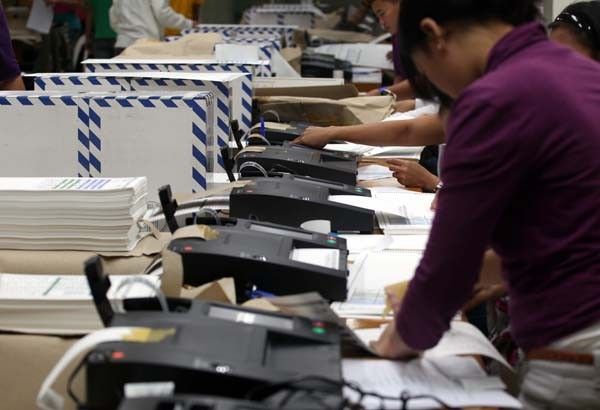Commentary: Why do citizens prefer automated elections?

Suggestions from some quarters to revert to manual elections go against the grain of evidence. The shift towards an automated polling system that started two decades ago has yielded favorable results in terms of citizen satisfaction with the accuracy, transparency and speedy reporting of election outcomes.
The long history of manual elections in the Philippines was accompanied by electoral fraud. This led to public outcry that triggered policy efforts to transition towards automated elections.
In 1997, Republic Act No. 8436 was passed into law, which authorized the Commission on Elections to implement an automated election system in the May 1998 polls. But the automated system was only used in a number of provinces, including Lanao del Sur, Maguindanao, Sulu, and Tawi-Tawi. Moreover, the machines used in some parts of the Autonomous Region of Muslim Mindanao were beset with defects in the counting process while irregularities in subsequent elections discouraged the public from trusting the automated system.
It was not until after the 2004 elections that the use of the automated system was again given attention owing to the controversy caused by vote padding and shaving. Republic Act No. 8436 was then amended by Republic Act No. 9369 in 2007 or the Election Automation Law. In addition to the use of appropriate technology for the national and local elections, the amendment calls for transparent, credible, fair and accurate elections.
During the 2008 elections in the ARMM, the paper-based system and the direct recording electronic (DRE) election system were tested. Both systems made the process of voting, counting and canvassing faster while winning candidates were announced within 48 hours after the closing of polls.
An automated election system was implemented in the 2010 national polls. The Comelec primarily selected the paper-based election system over other technologies such as the DRE because of its paper audit feature.
Although not perfect, the 2010 automated elections altered the conduct of elections in the Philippines. Compared to past elections where the winners were known after weeks or months, local winners were determined in a few hours while half of the national winners were known after a day. More importantly, election-related violence and public anxiety was significantly reduced as the time for counting and canvassing of votes was cut short.
Observers of the 2013 elections made similar assessments. The were some glitches, however, it was also described as generally peaceful and organized especially due to the smaller volume of election-related violence as compared to previous election years. Both the 2010 and 2013 elections made use of the paper-based election system and Precinct Count Optical Scan (PCOS) machines. In the 2016 elections, the PCOS machines were replaced by Vote Counting Machines (VCMs) with enhanced security features.
The Philippines has adopted the paper-based election system composed of an Election Management System (EMS), PCOS/Vote Counting Machines, and a Consolidation/Canvassing System. This type of system by Comelec’s work model does not encompass a fully automated process. It uses paper ballots which the voter still has to manually fill out.
The EMS, which manages all data and information involving the automated elections, prepares the ballots used in the national and local elections for every province, city and municipality throughout the Philippines. In terms of practical voting experience, its difference from the manual elections is that the voter no longer writes the names of preferred candidates but instead shades the corresponding oval beside the candidate’s name.
Afterwards, the ballot is fed into a vote counting machine which reads the ballot and records the votes. It is a form of Optical Mark Reader technology that scans data based on marks detected by the computer. The vote counting machine contains a removable compact flash card that stores the election results and audit logs. It also contains a source code that serves as instructions for the machine. In addition, the PCOS machine has a built-in audit paper trail function.
In July 2016, Pulse Asia conducted a nationwide survey on the May 2016 elections. The fieldwork for this Ulat ng Bayan survey was conducted from July 2 to 8, 2016 by means of face-to-face interviews based on a sample of 1,200. It has a ± 3% error margin and a 95 percent confidence level.
The survey indicates a generally positive public perception of the conduct of the May 2016 elections. In particular, almost all respondents think that the release of election results in their place was fast (92 percent), characterize the conduct of the elections in their respective areas as orderly (93 percent), and claim that they did not observe any occurrence of electoral violence (95 percent). Sizeable to huge majorities, on the other hand, opine that there was no vote buying and cheating in their place (66 percent and 83 percent, respectively) and describe the electoral results as believable (89 percent).
The Parish Pastoral Council for Responsible Voting also reported that 96.14 percent of election results were transmitted to the transparency server within three days after elections, as compared to 90 percent in 2010 and 76 percent in 2013. The 2016 voter turn-out, which, at 81 percent, is higher compared to the 77 percent in 2013 and 74 percent in 2010.
The historically high turnout is an important indicator of the credibility of the 2016 elections, with various election stakeholders and citizen groups assessing the polls as having been managed far better than the past automated elections despite some problem areas. It is clear that the rapid transmission of results that dramatically shortened the period of indeterminacy and contributed in elevating the credibility of the automated 2016 elections. The automated election system leaves room for improvement but we cannot turn our backs from the progress that has been made. The line of march is pointed towards automated elections.
Dr. Francisco A. Magno is a trustee and convenor of the Right Governance and Open Governments Program of the Stratbase ADR Institute, a partner of Philstar.com.
- Latest




























